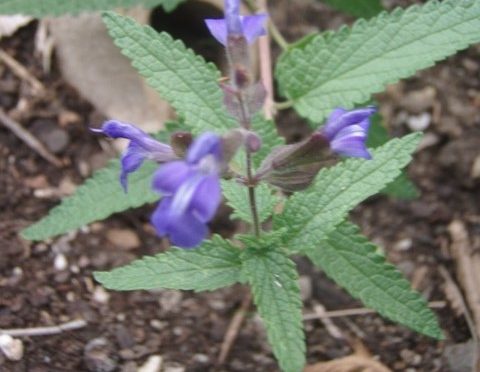Salvia calolophos: is a small upright shrubby Salvia from Argentina, 30-60 cm H with small blue flowers, loving full sun and good drainage.

Salvia calolophos is a small tough hardy plant ideal for rockeries.
Flowers: are bright blue with violet tones, a large falcate hood which is often has a blunt end. The stigma and anthers are nestled just within that end, transferring the pollen when an insect comes into the flower. The two side lobes are nicely flared and the elongated lower lip is slightly split and clearly shows a prominent white beeline.
Flowering in spring through out the summer and into autumn. Flowers appear along the stem in small whorls of 4 flowers, on a much branched main stem. A perfect insect/ bee flower with the large white beeline to guide them into the flower.
Calyces: are large, pink/ mauve, greenish when not exposed to sun, an almost fluted or vase shaped, with prominent veins.
Very colourful when flower has dropped. They remain and gradually dry, adding to the charm of the plant.
Leaves: are grass green, sometimes lobed, long, softly textured, fissured with rounded crenations along the edges.
Salvia calolophos is also known as Puna Sage, this small shrub, if grown hard in full sun and good drainage, can grow into a nice neat clump.
Ideal plant to grow in a gravel garden or a rockery, both of which should have good drainage. Plant with other, pale pink, yellow, white or pale blue/ mauve coloured small shrubs and perennials that also like those growing conditions.
Tough and hardy in these conditions for summer heat and winter cold, withstanding a mild frost.
At the end of summer is the time to tidy the plant, by cutting out any dead or twiggy stems, collecting any seed and cutting off the flowering stems. Feed and mulch well. Topping up the mulch in spring to keep the root area cool over the hot dry summer months. Feed again as the new growth is beginning to appear.
Propagation: by usually tip cuttings, taken from new growth in spring and early summer. Seed can also be sown in spring/ early summer.
Not available
Back to Varieties



